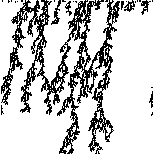
CCM (Chemical Casting Model, or Chemical-Computation Model) is a model for emergent computation.
CCM works only with local information, i.e., each reaction (unit action)
in CCM refers only a few data, and there is no global plan (i..e., no program) for the computation.
CCM is based on a production system (a type of rule-based computation method), which is similar to chemical
reaction systems (rather than conventional production systems used for
developing expert systems). Two features of CCM are as follows.
- CCM works with locally-defined evaluation functions,
which is called local order degrees.
- The order of reactions (rule applications) is
random (or, stochastic or non-deterministic).
Randomness is a source of emergence.
In addition, catalysts do not change by reactions but affects the reaction velocity, a type of tunneling effect is caused by reaction rule composition, and annealing-like effects are caused by Frustration Accumulation Method (FAM).
Continue ...


